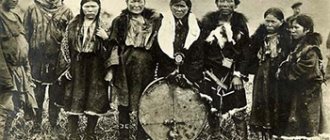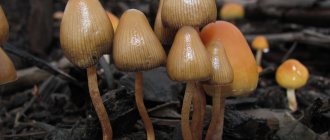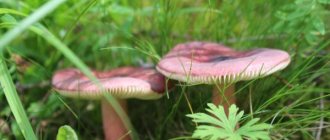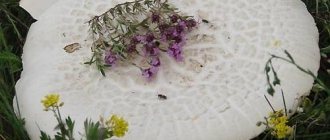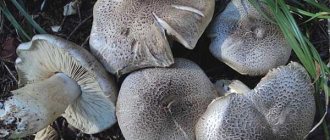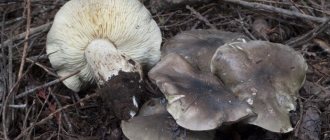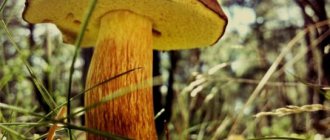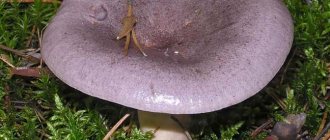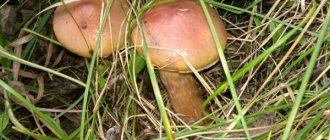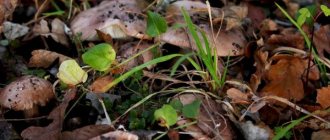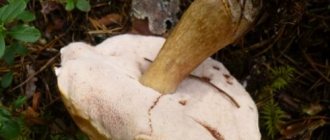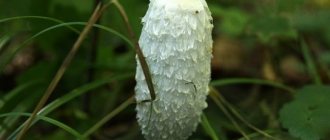Maiden's umbrella mushroom is an edible mushroom that is eaten boiled, fried, baked or pickled. It belongs to the champignon family, however, given the fact that it is rare and subject to protection, it is worth refusing to collect and eat it.
It can appear singly or in small groups, but in any case, the favorite soil is considered to be:
- pine and mixed forests;
- shady meadows.
Description
The umbrella mushroom is a basidiomycot. It belongs to the class Agaricomycetes, part of the order Agariaceae, the Champignon family. Most umbrellas are included in the genus Macrolepiotes.
Umbrella mushrooms are edible (category 2-4) and poisonous. To correctly distinguish poisonous counterparts, you should read the description of the main species. The fruit has a capped body structure ranging from small to large in size.
The fruit got its name because of its elongated stem. At its end there is a dome cap, which looks like a cane umbrella when open.
hat
The cap reaches 10-40 cm, which depends on the type of fruit. The lower part is up to 38-45 cm in length. The upper one is distinguished by a whitish color with inclusions. These are the scales that the umbrella mushroom may show when ripe. The shape of the cap varies from ovoid and hemispherical to almost flat, reminiscent of a wide umbrella.
Regardless of the variety, the fruit has a central elevation, similar to a small mound.
The plates are located frequently and are poorly attached to the stem. As the fruit grows, they darken and turn gray. The spores are white or cream-colored.
Leg
The lower part of the fruit is cylindrical, sometimes flat or inclined. It is hollow inside and colored when cut. There is a small compaction at the base that looks like tubers.
The leg has a narrow or wide ring. It is film-like in structure. It's easy to move. Ring color: white or brown. It comes in two colors: white at the top and dark at the bottom.
a brief description of
The main distinguishing feature of this mushroom is its cap, because of the appearance of which it actually received its name. Its diameter varies from 4 to 7 centimeters, but can sometimes reach 10 centimeters. It is thin-fleshed, and its shape changes as the individual matures. Thus, it can be ovoid or convex, bell-shaped or umbrella-shaped. In any case, it is complemented by a low slide, thin and fringed edges. The surface is almost perfectly white, but the tubercle may be brownish. It is completely covered with scales - initially their color is white or nutty, but then they darken, especially in the center of the cap.
As for the pulp, it is mostly white, only at the base of the stem it is red. The smell is not mushroom-like, but rather reminiscent of radish. There is no pronounced taste.
Leg - its height can reach up to 16 centimeters, and its thickness does not exceed 10 millimeters. It is characterized by a cylindrical shape, narrows towards the top and thickens slightly at the bottom, and very rarely can be curved. Always hollow and fibrous. Its surface is white and smooth, but over time it can turn brown.
The plates are almost always frequent and free, complemented by a cartilaginous collarium. They have smooth edges and can be separated from the cap without much effort. Spore powder is either white or cream-colored.
Ecology and distribution of parasol
These mushrooms grow in the soil of mixed and pine forests, as well as in meadows. They can be found alone, but in rare cases they are found in small groups.
- Saber-toothed tiger
- 50 facts about kangaroos
- long eared hedgehog
- Cross spider
- Reptiles
- 72 facts about plants
Girls' umbrellas are common in Eurasia: France, Poland, Slovakia, the Czech Republic, Germany, Ukraine, Estonia, Finland, as well as the British Isles. In our country, these mushrooms are found on Sakhalin and the Primorsky Territory; in the European part of Russia they are extremely rare.
The harvest season is August-October.
Where does it grow
Prevalence is noted in the following areas:
- Eurasia;
- France and Germany;
- Poland and Czech Republic;
- British Isles;
- Slovakia and Estonia;
- Ukraine and the Balkans;
- Primorsky Krai and Sakhalin.
The collection season lasts from August to October inclusive.
Reasons for disappearance
The factors that reduce the population of such a fungus are:
- frequent forest fires;
- over-deforestation;
- Soil pollution;
- soil compaction, in particular trampling by livestock;
- high recreational loads.
The maiden umbrella mushroom lends itself well to cultivation, which makes it possible to preserve it as a pure culture and also to breed it under natural conditions.
Time and place of fruiting
The maiden umbrella mushroom is quite rare; it prefers pine and mixed forests, and can appear in meadows.
It grows both singly and in groups. The main place of distribution is Eurasia. Familiar to mushroom lovers in Britain, France, Germany, Finland, Poland, Czech Republic, Slovakia, Ukraine and Estonia. The north of the Balkan Peninsula may also be where the umbrella grows.
In Russia it is now extremely rare, but you can see it in the Primorsky Territory, on Sakhalin. Listed in regional Red Books:
- Astrakhan, Kemerovo, Sakhalin, Saratov regions;
- Primorsky, Khabarovsk Territory;
- Republics of Altai, Bashkortostan, Tyva and Adygea.
Ripening and fruiting occur in August - October.
Similar species
Blushing umbrella
The only similar mushroom is considered to be the blushing umbrella. That is why for some time they were classified as one group. The visual difference lies in the darker cap, as well as its larger size - it reaches 15 cm in diameter. The umbrella, which turns red at a young age, also has an ovoid shape, and later becomes similar to its name. It can be collected from July to October; it grows in mixed or spruce forests. Frequent neighbor of anthills. At the peak of fruiting it is found growing in large groups. An edible mushroom, it has excellent taste, but its stem is quite hard, so it is prepared without it.
Growing at home and in the country
To grow an umbrella mushroom, you need to find a mycelium in the forest with an old, flabby fruit, which will serve as a distributor of spores in your summer cottage. At home you need to pin its cap on a branch and let it hang over the prepared soil.
As the mushroom dries, the spores ripen and fall out onto the ground. It must contain a sufficient amount of calcium carbonate. However, it can be replaced with a concentrate intended for growing champignons.
Caring for the parasol mushroom at home is quite difficult, it is very finicky, and therefore it is better to do it in its natural habitat. However, this method is also quite problematic. While looking after a certain clearing, it cannot be completely protected from harvesting by other mushroom pickers.
Despite this, you can increase the umbrella population in your place of residence if, during collection, you cut off the cap of an old specimen and hang it on a branch directly above where it grows.
Evaluation of taste qualities, medicinal properties, benefits and possible harm
The variety does not have any medicinal properties. Used fried and boiled, good in salads and as a separate dish. The leg is usually not used for cooking, but it is indispensable for mushroom broth. After boiling it should be thrown away. Caution should be exercised in use for diseases of the gastrointestinal tract, pancreas or liver diseases. A large amount of fungus is harmful even to a healthy body. With uncontrolled consumption, bloating occurs, spasms and pain are possible. Children under 5 years old, as well as nursing women, are prohibited from eating it.
Literature
- Wasser S.P.
Flora of mushrooms of Ukraine. Agaric mushrooms / resp. ed. I. A. Dudka. - K.: “Naukova Dumka”, 1980. - P. 296-298. - Mushrooms: Directory / Transl. from Italian F. Dvin. - M.: “Astrel”, “AST”, 2001. - P. 68. - ISBN 5-17-009961-4.
- Lesso T.
Mushrooms, key / trans. from English L. V. Garibova, S. N. Lekomtseva. - M.: “Astrel”, “AST”, 2003. - P. 166. - ISBN 5-17-020333-0. - Reference guide: Mushrooms / resp. for the release of Yu. G. Khatskevich. - Mn.: Harvest, 2002. - P. 262. - 480 p. — 7000 copies. — ISBN 985-13-0913-3.
- Harding P.
Mushrooms / Translation from English. D. S. Shchigel. - M.: “Astrel”, “AST”, 2002. - P. 24. - ISBN 5-17-011765-5.
Interesting Facts
- With regular use of the maiden umbrella for food, an improvement in the condition of the cardiovascular and nervous systems has been noted.
- Increasing resistance to infectious diseases.
- It helps reduce the risk of tumors, stimulates the immune system, and has an antioxidant effect.
Video
Are umbrella mushrooms good for you?
Surely you have heard that mushrooms can benefit the human body. Provided, of course, that they are edible and collected in the right place. In view of this, we can confidently say that an umbrella, when used correctly, can improve your well-being. It contains substances that have a weak antitumor effect.
, thereby inhibiting the development of benign neoplasms.
In addition, these substances have a positive effect on the body's cells, helping them to renew themselves regularly and do so correctly. Umbrella mushrooms also have a positive effect on hematopoiesis and the functioning of the cardiovascular system.
.
And, of course, do not forget that all mushrooms have a very low glycemic index
. Therefore, if you want to lose weight, be sure to include this product in your diet.
How to properly prepare umbrellas
Umbrellas, like many other mushrooms, are healthy and nutritious and should be collected young, when the cap is not yet fully opened. Mature representatives may begin to feel bitter. How to cook umbrella mushrooms? The stem is removed, and the cap must be subjected to heat treatment - fried, boiled, stewed, pickled, salted. Umbrellas can be pre-dried or frozen, and then used to prepare a wide variety of dishes - soups, appetizers, salads, baking fillings and pancakes.
Umbrella mushrooms should not be collected near industrial enterprises, garbage dumps, large highways and railroad tracks. They can accumulate harmful and dangerous substances that threaten human health and life.
Umbrella mushroom recipes:
- a large umbrella cap is cleared of scales and washed well, salt and pepper to taste, and then fried on both sides in vegetable oil - simple and very tasty;
- you can fry the caps, previously dipped in batter, or rolled in breadcrumbs or flour, this is original and quick;
- special fans cook grilled umbrellas on the grill of an oven or outdoor barbecue, marinating them briefly in lemon juice with herbs and garlic, an interesting and affordable option;
- dry and aromatic umbrella cooks quickly, it is good for broth, as an additional ingredient for appetizers and sandwiches.
The unique taste and rich mushroom aroma are the main advantages of the umbrella. Nutritionists note their unique composition and high nutritional value, content of amino acids, fiber, salts, vitamins and minerals. The beneficial mushroom is widely used in folk medicine for preventive and therapeutic purposes.
